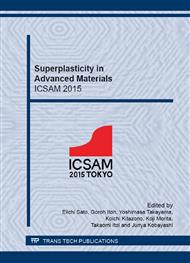p.51
p.59
p.66
p.72
p.78
p.84
p.89
p.95
p.100
Unification of Physics during Super Plastic Flow in Advanced Materials
Abstract:
In the framework connected with the unification of physics, the activation energy for super plastic flow in advanced materials has been obtained by applying the new quantum mechanics and relativistic model proposed by Muñoz-Andrade. This new model allows the direct evaluation of the activation energy for super plastic flow at instantaneous thermo-mechanical material forming conditions. Also, in order to establish the phenomenology and mechanics of super plastic flow, the dependence on strain rate and phase velocity de Broglie is obtained, for the reason that the nature wavelength of the cellular dislocations is essential in the association with coupled mechanisms during super plastic flow, such as grain boundary sliding, cooperative grain boundary sliding and self-accommodation process. In conclusion, cellular dislocation dynamics is a nature mechanism during super plastic flow in advanced materials. The results obtained in this work are in a closed agreement with results reported previously.
Info:
Periodical:
Pages:
78-83
Citation:
Online since:
January 2016
Authors:
Price:
Сopyright:
© 2016 Trans Tech Publications Ltd. All Rights Reserved
Share:
Citation:


